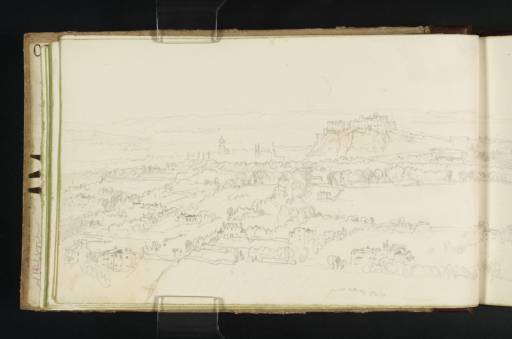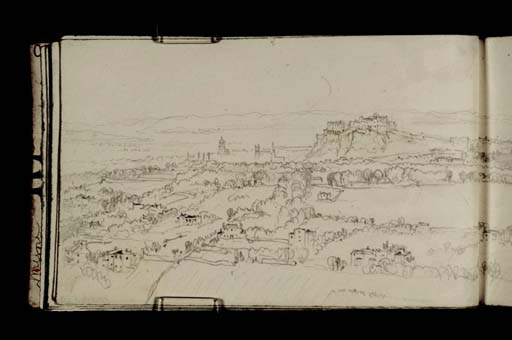J.M.W. Turner
>
1830-35 Annual tourist
>
Scotland 1831
>
Abbotsford Sketchbook
>
Artwork
Joseph Mallord William Turner Edinburgh, from Blackford Hill 1831
Image 1 of 2
Joseph Mallord William Turner,
Edinburgh, from Blackford Hill
1831
Joseph Mallord William Turner 1775–1851
Folio 7 Verso:
Edinburgh, from Blackford Hill 1831
D25939
Turner Bequest CCLXVII 7a
Turner Bequest CCLXVII 7a
Pencil on off-white wove writing paper, 113 x 185 mm
Accepted by the nation as part of the Turner Bequest 1856
Exhibition history
1975
Turner and the Poets: Engravings and Watercolours from his Later Period, Marble Hill House [Greater London Council], Twickenham, April–June 1975, University of East Anglia, Norwich, June–July 1975, Central Art Gallery, Wolverhampton, July–August 1975 (XIV).
References
1909
A.J. Finberg, A Complete Inventory of the Drawings of the Turner Bequest, London 1909, vol.II, p.857, CCLXVII 7a, as ‘Edinburgh, from Braid Hills, See Engraving, Scott’s Poems 1833.’.
1980
Gerald Finley, Landscapes of Memory: Turner as Illustrator to Scott, London 1980, reproduced pp.132 pl.57 as ‘Edinburgh from Blackford Hill’, 136.
1975
Mordechai Omer, Turner and the Poets: Engravings and Watercolours from his Later Period, exhibition catalogue, Marble Hill House [Greater London Council], Twickenham 1975, p.[32] cat.XIV.
1990
Luke Herrmann, Turner Prints: The Engraved Work of J.M.W. Turner, Oxford 1990, pp.199, 258 note 30.
2000
Eric Shanes, Evelyn Joll, Ian Warrell et al., Turner: The Great Watercolours, exhibition catalogue, Royal Academy of Arts, London 2000, p.187 under cat.78.
Turner’s drawing of Edinburgh from Blackford Hill (across the present page and folios 8, 11 and 13; D25940, D25946, D25950; CCLXVII 8, 11, 13) was made in preparation for a watercolour to be engraved for the frontispiece to Marmion, volume 7 of Sir Walter Scott’s Poetical Works: Edinburgh from Blackford Hill circa 1832 (whereabouts unknown).1 The choice of the subject was made early on, with Robert Cadell writing to Scott, ‘I have visited Blackford Hill early in the morning & am convinced that the view from it cannot be passed over’.2
The view was already familiar to Turner as he had made sketches of Edinburgh from the Braid Hills, which are just a little further to the south of Blackford, in 1818 (Tate D13402; Turner Bequest CLXV 45a). Those sketches were made in connection to illustrations for Scott’s Provincial Antiquities and Picturesque Scenery of Scotland, although, in the event, Augustus Wall Callcott made the illustration.
Turner made this sketch on 15 August 1831 and was accompanied by the publisher of the Poetical Works, Robert Cadell, who wrote about the visit in his diary. The two had breakfasted together at Cadell’s Edinburgh office, and at about ten they set off in a carriage for the hill. Turner apparently struggled with the climb as he depicted himself at the bottom left of the watercolour being pulled up the hill by Cadell. They stayed for over an hour while Turner made this single, detailed drawing before descending.3
Turner’s drawing shows the view north towards Edinburgh and beyond to the Firth of Forth and the distant coast of Fife. Many buildings and landscapes can be made out in the detailed sketch, and others, drawn sketchily, can be made out with references to the engraving.
Beyond the fields and a few houses dotted around the foreground is the Blackford area of town. The most prominent landmark on the present page is Edinburgh Castle, which sits upon Castle Rock at the centre of the city. To its left are three churches: the dome of St George’s in Charlotte Square (now the West Register House), the tower of St John’s and the spire of St Cuthbert’s. Beyond this are the Firth of Forth and the coast of Fife, with the Grampian Mountains in the far distance. As it has been pointed out by Eric Shanes, the wide panorama of the sketch was compressed substantially to fit the details into the space of the engraving.4
The sketch continues on folio 8 where Calton Hill is a prominent feature and the picture is framed by the edge of the great rock, Arthur’s Seat. Turner also peeled back that and two more pages to continue the view to the right further still on folios 11 and 13.
Thomas Ardill
September 2009
How to cite
Thomas Ardill, ‘Edinburgh, from Blackford Hill 1831 by Joseph Mallord William Turner’, catalogue entry, September 2009, in David Blayney Brown (ed.), J.M.W. Turner: Sketchbooks, Drawings and Watercolours, Tate Research Publication, December 2012, https://www


